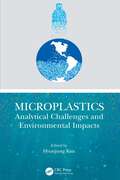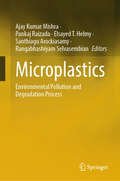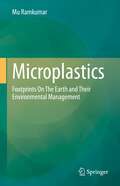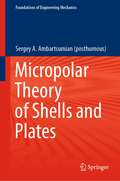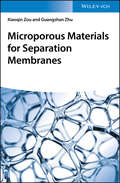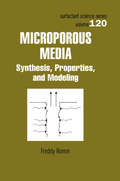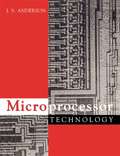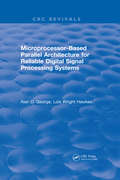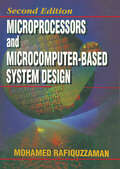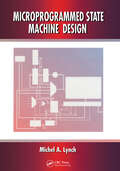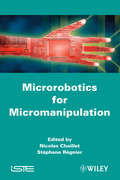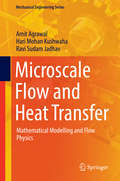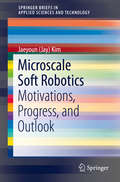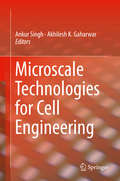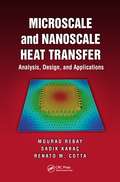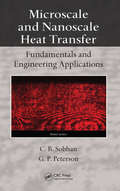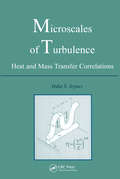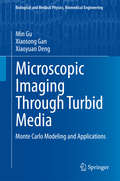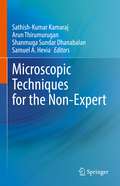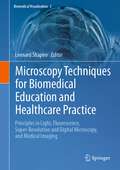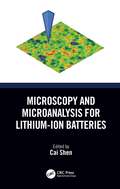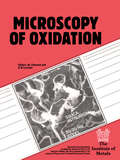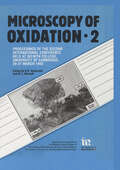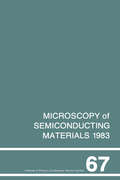- Table View
- List View
Microplastics: Analytical Challenges and Environmental Impacts
by Hyunjung KimThis book introduces the growing problem of microplastics pollution in the soil and aquatic environment and its interaction with other chemical pollutants. Further, it provides a detailed review of existing analysis techniques for characterization, separation, and quantification of microplastics including their merits and demerits with possible suggestions. Additionally, the regulatory need and actions for improving the economic and quality of plastic recycling, curbing microplastic littering, and stakeholders, researchers, and recyclers challenges are reviewed comprehensively. Priorities are identified to bridge the knowledge gaps for appropriate management of existing challenges. Features: Provides a comprehensive description of the fate and environmental impact of microplastics, along with various characterization methods Overviews the interaction of microplastics with other toxic chemicals and further their transportation in environment Explains how microplastics enter in environment and its effect on biota and human health Analyses existing analytical techniques for characterization of microplastics Describes societal awareness related to use of plastic and discarding This book focusses on graduate students, researchers in environmental engineering, ecological engineering, chemical and biological engineering, plastics and material sciences/engineering, waste management. materials science.
Microplastics: Environmental Pollution and Degradation Process
by Ajay Kumar Mishra Santhiagu Arockiasamy Rangabhashiyam Selvasembian Pankaj Raizada Elsayed T. HelmyThis book presents microplastics pollution in land and water bodies, their hazardous effects, characterization approaches, and suitable means of utilizing advanced treatment options to solve the problem. It is mainly understood that microplastic pollutants are associated with water bodies, however there also exists soil contamination and their interaction with the food web. The discussions related to strategies and policies for the management of microplastics are very limited. This book not only narrows microplastic pollution in marine or fresh water bodies, but also takes into account the terrestrial environment, including the toxicity effects, characterization aspects and treatment approaches. The main feature of the book includes latest research related to microplastics pollution, examining the different health effects including environmental (related) issues and highlights the advances in treatment approaches. The book serves as a guide with an up-to-date information on microplastics related problems, useful for students, researchers, professionals/environmentalists and also as a reference for policy makers.
Microplastics: Footprints On The Earth and Their Environmental Management
by Ramkumar MuthuvairavasamyThis book presents information on the origin and distribution of microplastics, evaluates the methods of their detection, documents their interactions with natural systems, and analyzes the current understanding of their management. Owing to the size, varied compositions, pathways of transport, accumulation and myriad processes of interactions with ecosystems, the microplastics pose severe threats to ecosystem services and natural environmental systems. Therefore, the environmental challenges that microplastics present and the strategies to mitigate their harmful impacts are of great importance to the scientific community, and only a few publications exist that collate this information in a single resource. The book aims to be a comprehensive resource for students, professionals and practitioners of environmental studies on microplastics and how to better understand the threats they pose and the practices to manage them.
Micropolar Theory of Shells and Plates (Foundations of Engineering Mechanics)
by Sergey A. Ambartsumian (posthumous)For the first time, the Micropolar Theory of Elasticity is applied to solving a wide variety of problems connected to the specifics of nanomaterials. Namely, their unique physical-mechanical characteristics and behaviors under various stress-induced conditions.These theories have been constructed based on the equations of the classical theory of elasticity as well as other equations that have till now remained untouched in their application to molecular theories of solid deformable media. The book also introduces a new applied micropolar theory of thin shells which is based on Cosserat's pseudo-continuum. It explores the theory’s application to a category of nanomaterial shells and plates previously neglected from classical theories due to their unconventional size and structure. Theoretical results are accompanied by solutions of certain problems, essential for various applications.The book consists of six chapters. The first chapter is a review of the essential data on the non-symmetric theory of elasticity. The second and third chapters are devoted to various theories of plate bending and solutions to some basic problems. Chapter four refers to membrane or, so-called, momentary shell theory. Chapter five deals with the theory of very shallow shells. Finally, chapter six presents the geometry of the nonlinear theory of plates and the theory of very shallow shells.The book is intended for researchers, postgraduate students, and engineers, interested in the design of structures from nanomaterials and in the problems of mechanics of deformable bodies, theories of shells and plates, and their applications in micromechanics.
Microporous Materials for Separation Membranes
by Guangshan Zhu Xiaoqin ZouA guide to membrane separation based on a variety of porous materials with promising separation applications Microporous Materials for Separation Membranes offers an in-depth guide that explores microporous materials? potential for membrane applications. The authors?two experts on the topic?examine a wide range of porous materials that have application potential including: microporous silica, porous carbons, zeolites, metal-organic frameworks (MOFs), and porous organic frameworks (POFs). Comprehensive in scope, the book covers a broad range of topics on membrane separations such as: hydrogen recovery, carbon dioxide capture, air purification, hydrocarbon separation, pervaporation, and water treatment. In addition, this up-to-date resource explores the most recent materials for preparing microporous membranes and explores the most promising applications for industrial use. This important book: -Examines the use of microporous materials as membranes to perform with different gases and liquids -Offers an overview of the basic knowledge of membrane separation and an intense examination of separations -Describes the state-of-the-art of membrane separation with porous materials -Highlights the most promising applications of industrial interest Written for scientists working in the fields of membranes, gas and liquid, Microporous Materials for Separation Membranes offers a valuable guide to the potential of microporous materials for membrane applications.
Microporous Media: Synthesis, Properties, and Modeling (Surfactant Science Ser. #120)
by Freddy RommMicroporous Media presents new developments from nearly a decade of advancement. Written by a leading researcher in the field, this reference provides examples of the most original scientific and technical research impacting studies in porosity and microporosity, and illustrates methods to forecast the properties of microporous structures for impro
Microprobe Characterization of Optoelectronic Materials
by Juan JimenezEach chapter in this book is written by a group of leading experts in one particular type of microprobe technique. They emphasize the ability of that technique to provide information about small structures (i.e. quantum dots, quantum lines), microscopic defects, strain, layer composition, and its usefulness as diagnostic technique for device degradation. Different types of probes are considered (electrons, photons and tips) and different microscopies (optical, electron microscopy and tunneling). It is an ideal reference for post-graduate and experienced researchers, as well as for crystal growers and optoelectronic device makers.
Microprocessor Technology
by J S Anderson'Microprocessor Technology' provides a complete introduction to the subject of microprocessor technology using the Z80 and 6502 processors. An emphasis on fault-finding and repair makes this an ideal text for servicing courses including City & Guilds 2240 in the UK, microelectronics units on BTEC National/Advanced GNVQ and City & Guilds 7261 Microprocessor Technology. It will also provide a refresher course for those on 'bridging' and micro appreciation courses where a measure of comparative studies is required. Clear and concise explanations are supported by worked examples, tutorials, long answer questions and assignments giving students the opportunity to test their knowledge as they progress through the course as well as providing an essential revision tool in the run-up to exams.
Microprocessor-Based Parallel Architecture for Reliable Digital Signal Processing Systems
by Alan D. GeorgeThis book presents a distributed multiprocessor architecture that is faster, more versatile, and more reliable than traditional single-processor architectures. It also describes a simulation technique that provides a highly accurate means for building a prototype system in software. The system prototype is studied and analyzed using such DSP applications as digital filtering and fast Fourier transforms. The code is included as well, which allows others to build software prototypes for their own research systems. The design presented in Microprocessor-Based Parallel Architecture for Reliable Digital Signal Processing Systems introduces the concept of a dual-mode architecture that allows users a dynamic choice between either a conventional or fault-tolerant system as application requirements dictate. This volume is a "must have" for all professionals in digital signal processing, parallel and distributed computer architecture, and fault-tolerant computing.
Microprocessors and Microcomputer-Based System Design
by Mohamed RafiquzzamanMicroprocessors and Microcomputer-Based System Design, Second Edition, builds on the concepts of the first edition. It discusses the basics of microprocessors, various 32-bit microprocessors, the 8085 microprocessor, the fundamentals of peripheral interfacing, and Intel and Motorola microprocessors. This edition includes new topics such as floating-point arithmetic, Program Array Logic, and flash memories. It covers the popular Intel 80486/80960 and Motorola 68040 as well as the Pentium and PowerPC microprocessors. The final chapter presents system design concepts, applying the design principles covered in previous chapters to sample problems.
Microprogrammed State Machine Design
by Michel A. LynchMicroprogrammed State Machine Design is a digital computer architecture text that builds systematically from basic concepts to complex state-machine design. It provides practical techniques and alternatives for designing solutions to data processing problems both in commerce and in research purposes. It offers an excellent introduction to the tools and elements of design used in microprogrammed state machines, and incoporates the necessary background in number systems, hardware building blocks, assemblers for use in preparing control programs, and tools and components for assemblers .The author conducts an in-depth examination of first- and second-level microprogrammed state machines. He promotes a top-down approach that examines algorithms mathematically to exploit the simplifications resulting from choosing the proper representation and application of algebraic manipulation. The steps involved in the cycle of design and simulation steps are demonstrated through an example of running a computer through a simulation. Other topics covered in Microprogrammed State Machine Design include a discussion of simulation methods, the development and use of assembler language processors, and comparisons among various hardware implementations, such as the Reduced Instruction Set Computer (RISC) and the Digital Signal Processor (DSP). As a text and guide, Microprogrammed State Machine Design will interest students in the computer sciences, computer architectects and engineers, systems programmers and analysts, and electrical engineers.
Microrobotics for Micromanipulation (Wiley-iste Ser. #466)
by Stéphane Régnier Nicolas ChailletMicrorobotics for Micromanipulation presents for the first time, in detail, the sector of robotics for handling objects of micrometer dimensions. At these dimensions, the behavior of objects is significantly different from the better known, higher scales, which leads us to implement solutions sometimes radically different from those most commonly used. This book details the behavior of objects at the micrometer scale and suitable robotics solutions, in terms of actuators, grippers, manipulators, environmental perception and microtechnology. This book includes corrected exercises, enabling engineers, students and researchers to familiarize themselves with this emerging area and to contribute to its development through scientific measures.
Microscale Flow and Heat Transfer: Mathematical Modelling and Flow Physics (Mechanical Engineering Series)
by Amit Agrawal Hari Mohan Kushwaha Ravi Sudam JadhavThis book covers concepts and the latest developments on microscale flow and heat transfer phenomena involving a gas. The book is organised in two parts: the first part focuses on the fluid flow and heat transfer characteristics of gaseous slip flows. The second part presents modelling of such flows using higher-order continuum transport equations. The Navier-Stokes equations based solution is provided to various problems in the slip regime. Several interesting characteristics of slip flows along with useful empirical correlations are documented in the first part of the book. The examples bring out the failure of the conventional equations to adequately describe various phenomena at the microscale. Thereby the readers are introduced to higher order continuum transport (Burnett and Grad) equations, which can potentially overcome these limitations. A clear and easy to follow step by step derivation of the Burnett and Grad equations (superset of the Navier-Stokes equations) is provided in the second part of the book. Analytical solution of these equations, the latest developments in the field, along with scope for future work in this area are also brought out.Presents characteristics of flow in the slip and transition regimes for a clear understanding of microscale flow problems;Provides a derivation of Navier-Stokes equations from microscopic viewpoint;Features a clear and easy to follow step-by-step approach to derive Burnett and Grad equations;Describes a complete compilation of few known exact solutions of the Burnett and Grad equations, along with a discussion of the solution aided with plots;Introduces the variants of the Navier-Stokes, Burnett and Grad equations, including the recently proposed Onsager-Burnett and O13 moment equations.
Microscale Soft Robotics
by Jaeyoun Jay KimThis book presents the technological basics and applications of small-scale (mm to sub-mm in length-scales) soft robots and devices, written for researchers in both academia and industry. Author Jaeyoun Kim presents technological motivations, enabling factors, and examples in an inter-linked fashion, making it easy for readers to understand and explore how microscale soft robots are a solution to researchers in search of technological platforms for safe, human-friendly biomedical devices. A compact and timely introduction, this book summarizes not only the enabling factors for soft robots and MEMS devices, but also provides a survey of progress in the field and looks to the future in terms of the material, design, and application aspects this technology demonstrates.
Microscale Technologies for Cell Engineering
by Ankur Singh Akhilesh K. GaharwarThis book offers readers cutting-edge research at the interface of polymer science and engineering, biomedical engineering, materials science, and biology. State-of-the-art developments in microscale technologies for cell engineering applications are covered, including technologies relevant to both pluripotent and adult stem cells, the immune system, and somatic cells of the animal and human origin. This book bridges the gap in the understanding of engineering biology at multiple length scale, including microenvironmental control, bioprocessing, and tissue engineering in the areas of cardiac, cartilage, skeletal, and vascular tissues, among others. This book also discusses unique, emerging areas of micropatterning and three-dimensional printing models of cellular engineering, and contributes to the better understanding of the role of biophysical factors in determining the cell fate. Microscale Technologies for Cell Engineering is valuable for bioengineers, biomaterial scientists, tissue engineers, clinicians, immunoengineers, immunologists and stem cell biologists, as it offers a review of the current cutting-edge cell engineering research at multiple length scale and will be valuable in developing new strategies for efficient scale-up and clinical translation.
Microscale and Nanoscale Heat Transfer: Analysis, Design, and Application
by Renato M. Cotta Sadik Kakaç Mourad RebayMicroscale and Nanoscale Heat Transfer: Analysis, Design, and Applications features contributions from prominent researchers in the field of micro- and nanoscale heat transfer and associated technologies and offers a complete understanding of thermal transport in nano-materials and devices. Nanofluids can be used as working fluids in thermal system
Microscale and Nanoscale Heat Transfer: Fundamentals and Engineering Applications
by C.B. Sobhan G.P. PetersonThrough analyses, experimental results, and worked-out numerical examples, Microscale and Nanoscale Heat Transfer: Fundamentals and Engineering Applications explores the methods and observations of thermophysical phenomena in size-affected domains. Compiling the most relevant findings from the literature, along with results from their own re
Microscales of Turbulence
by Vedat S ArpaciThis monograph presents the microscales of complex (buoyant, thermocapillary, two-phase, reacting, radiating, pulsating, etc.) turbulent flows and interprets heat and mass transfer correlations in terms of these scales. The author introduces a general methodology for the development of microscales for complex turbulent flows. Then he provides, by these scales, a fundamental interpretation for a number of momentum, heat, and mass transfer correlations which are assumed to be empirical. Lastly, he develops correlations in terms of these scales for environmentally and/or technologically important problems related to buoyancy driven flows, pulsating flows, diffusion flows, fires, etc.
Microscopic Imaging Through Turbid Media
by Min Gu Xiaosong Gan Xiaoyuan DengThis book provides a systematic introduction to the principles of microscopic imaging through tissue-like turbid media in terms of Monte-Carlo simulation. It describes various gating mechanisms based on the physical differences between the un scattered and scattered photons and method for microscopic image reconstruction, using the concept of the effective point spread function. Imaging an object embedded in a turbid medium is a challenging problem in physics as well as in bio photonics. A turbid medium surrounding an object under inspection causes multiple scattering, which degrades the contrast, resolution and signal-to-noise ratio. Biological tissues are typically turbid media. Microscopic imaging through a tissue-like turbid medium can provide higher resolution than transillumination imaging in which no objective is used. This book serves as a valuable reference for engineers and scientists working on microscopy of tissue turbid media.
Microscopic Techniques for the Non-Expert
by Sathish-Kumar Kamaraj Arun Thirumurugan Shanmuga Sundar Dhanabalan Samuel A. HeviaThis book covers fundamental microscopic techniques for Scanning Electron Microscopy (SEM), Transmission Electron Microscopy (TEM), Atomic Force Microscopy (AFM), and other microscopic tools. It provides step-by-step instructions and explanations of the basic fundamental concepts and mechanisms and guides the reader on resolving queries related to taking and analyzing microscopy images. The latest advancements and developments in microscopic equipment are described. Theoretical background on microscopy is also provided to enhance the reader’s understanding of microscopy techniques and tools. Microscopic Techniques for the Non-Expert is an ideal book for undergraduate and postgraduate students, as well as researchers with a background in environmental science, materials science, biomedicine, engineering, or bio-nanotechnology.
Microscopy Techniques for Biomedical Education and Healthcare Practice: Principles in Light, Fluorescence, Super-Resolution and Digital Microscopy, and Medical Imaging (Biomedical Visualization #2)
by Leonard ShapiroThis edited book has a strong focus on advances in microscopy that straddles research, medical education and clinical practice. These advances include the shift in power from conventional to digital microscopy. The first section of this book covers imaging techniques and morphometric image analysis with its applications in biomedicine using different microscopy modes. Chapters highlight the rich development of fluorescence methods and technologies; particle tracking techniques with applications in biomedical research and nanomedicine; the way in which visualizations have revolutionized taxonomy from gross anatomy to genetics; and the psychology of perception and how it affects our understanding of cells and tissues. The book’s first section concludes by exploring the use of CT modalities to evaluate anterior deformities in craniosynostosis. In the second section of the book, chapters on anatomical and cell biology education explore the history of anatomical models and their use in educational settings. This includes examples in 3D printing and functional human anatomical models that can be created using easily available resources and the use of biomedical imaging in visuospatial teaching of anatomy; the novel use of ultrasound in medical education and practice; and skill acquisition in histology education using a flowchart called a ‘decision tree’. This book will appeal to histologists, microscopists, cell biologists, clinicians and those involved in anatomical education and biomedical visualization, as well as students in those respective fields.
Microscopy and Microanalysis for Lithium-Ion Batteries
by Cai ShenThe past three decades have witnessed the great success of lithium-ion batteries, especially in the areas of 3C products, electrical vehicles, and smart grid applications. However, further optimization of the energy/power density, coulombic efficiency, cycle life, charge speed, and environmental adaptability are still needed. To address these issues, a thorough understanding of the reaction inside a battery or dynamic evolution of each component is required. Microscopy and Microanalysis for Lithium-Ion Batteries discusses advanced analytical techniques that offer the capability of resolving the structure and chemistry at an atomic resolution to further drive lithium-ion battery research and development. Provides comprehensive techniques that probe the fundamentals of Li-ion batteries Covers the basic principles of the techniques involved as well as its application in battery research Describes details of experimental setups and procedure for successful experiments This reference is aimed at researchers, engineers, and scientists studying lithium-ion batteries including chemical, materials, and electrical engineers, as well as chemists and physicists.
Microscopy of Oxidation
by G.W. LorimerMicroscopy of Oxidation: the proceedings of the Second International Conference Held at Selwyn College, University of Cambridge, in 1991.
Microscopy of Oxidation: Proceedings of the Second International Conference Held at Selwyn College, University of Cambridge, 29-31 March 1993
by S.B. NewcombMicroscopy of Oxidation: the proceedings of the Second International Conference Held at Selwyn College, University of Cambridge, on 29-31 1993.
Microscopy of Semiconducting Materials 1983, Third Oxford Conference on Microscopy of Semiconducting Materials, St Catherines College, March 1983
by A.G. CullisThis volume contains invited and contributed papers at the conference on Microscopy of Semiconducting Materials which took place on 21–23 March 1983 in St Cathernine's College, Oxford. The conference was the third in the series devoted to advances in microscopical studies of semiconductors.
